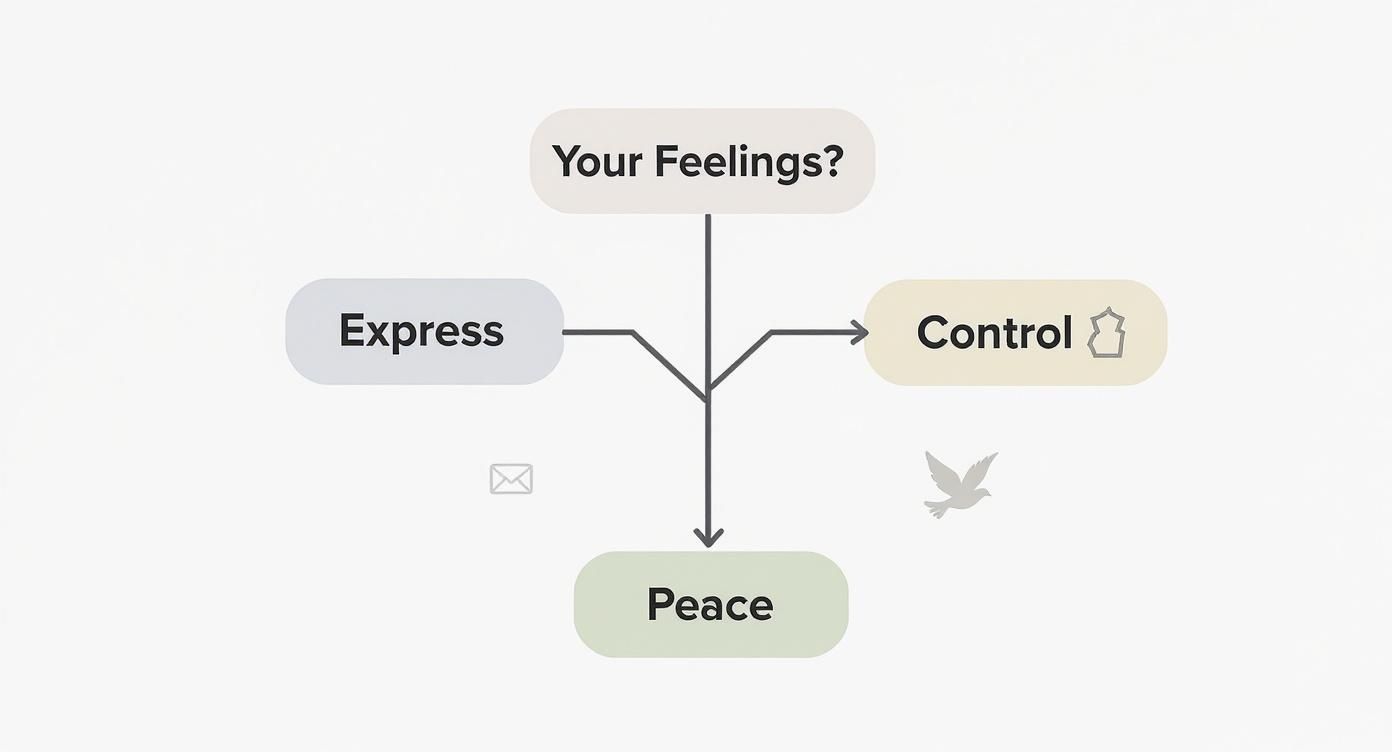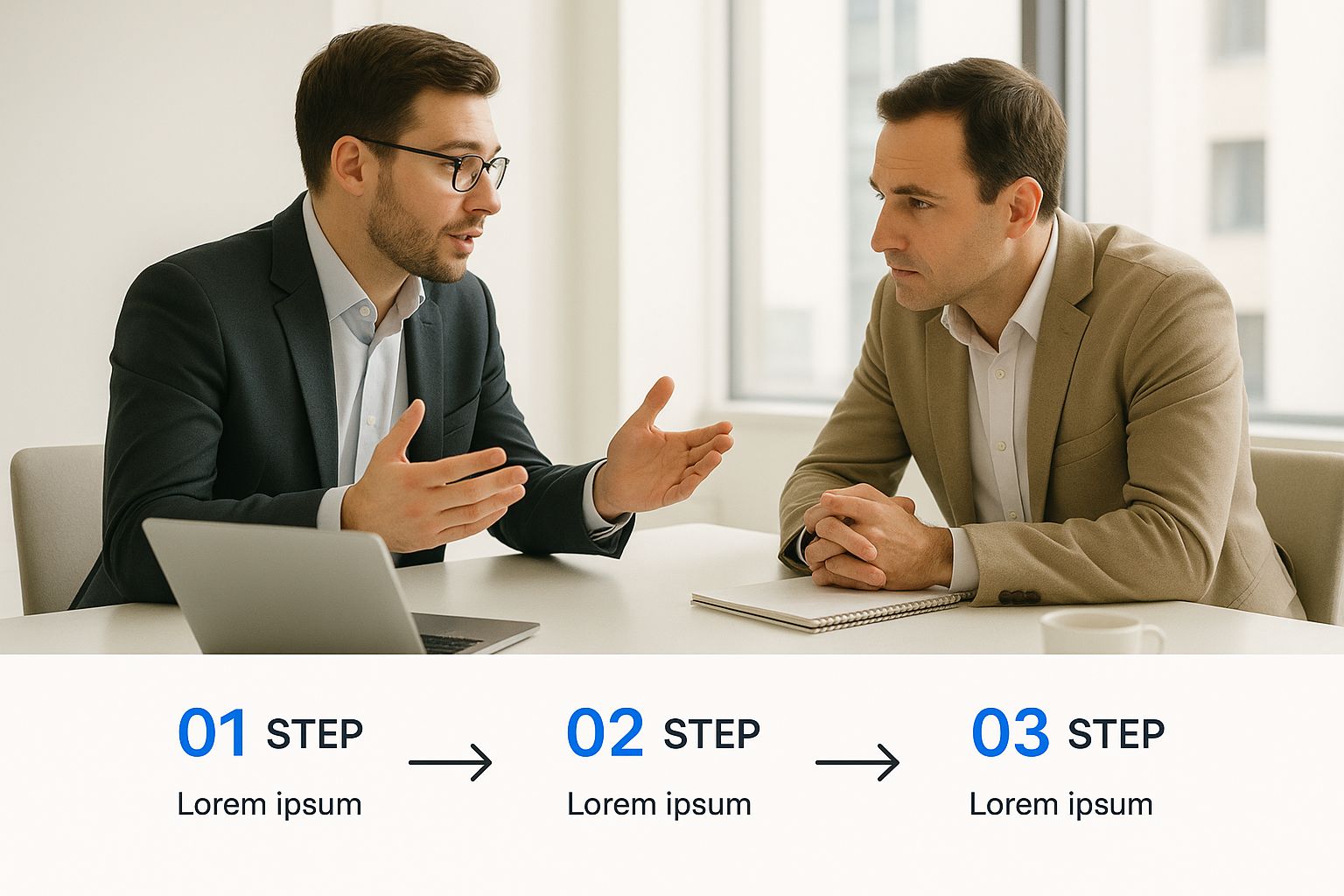When a relationship ends, the desire for "closure" can feel overwhelming. It isn't about getting a perfect apology or having one last dramatic conversation. Closure is the internal sense of peace that allows you to truly move forward, and it's essential for your long-term well-being.
Understanding Why Closure Matters for Your Well-being

A significant relationship is like a story, and an ending without answers can feel like a book with the last chapter missing. This leaves a void filled with "what ifs" and unresolved emotions. Finding closure in a relationship is your chance to write that final chapter for yourself and make sense of the ending.
This process is deeply personal and looks different for everyone. It might involve an honest conversation for one person, while for another, it could be a quiet journey of self-reflection. The goal is to integrate the experience into your life's story in a way that helps you grow.
The Emotional Cost of Unresolved Endings
Without closure, you might feel emotionally stuck, as if waiting for something that may never come. This limbo can be draining, contributing to challenges like workplace stress and personal anxiety. Your mind can get caught in a loop, replaying old moments and searching for answers.
This emotional weight can affect other areas of your life, making it hard to focus on new goals. Common challenges include:
- Lingering Sadness: A persistent feeling of loss that can cast a shadow over your days.
- Intrusive Thoughts: The person or breakup frequently comes to mind, even when you don't want it to.
- Difficulty Trusting: Feeling hesitant to open up to new people for fear of being hurt again.
Finding closure is less about the other person and more about reclaiming your own emotional energy. It’s a compassionate act of self-preservation that allows you to reinvest in your own happiness and future.
Building Resilience Through Acceptance
The path to closure is a powerful journey in building resilience. It involves accepting that some questions may never be answered and trusting in your own strength to heal. In contexts like India, where community ties are strong, pressure to "move on" can add complexity, but true healing takes time.
Approaching this journey with self-compassion is the first step toward transforming pain into personal growth. Professional support through counselling or therapy can offer a safe space to navigate these emotions and build your inner strength. Please note that any assessments mentioned here are informational and not a substitute for a professional diagnosis.
Recognising the Signs You Lack Closure

Feeling stuck after a relationship ends is very common and often signals a need for closure in the relationship. Noticing these signs without self-judgment is the first step toward healing. It’s not a weakness, but an acknowledgment that an important chapter feels unfinished.
This lack of resolution can appear in your thoughts, feelings, and daily behaviours. By identifying these patterns, you can address what's happening underneath and begin to build resilience and foster your happiness.
Emotional and Cognitive Patterns
Do you find your mind replaying old conversations or moments from the relationship? This is a natural but often unhelpful attempt to make sense of things. This mental loop can lead to anxiety and emotional exhaustion as you search for a missing piece of the puzzle.
These thoughts can be accompanied by a persistent sadness or low-grade depression that lingers long after the initial breakup. It's as if a part of you remains emotionally tied to the past, making it difficult to be present in your life. Idealising the past—remembering only the good times—can also create a powerful sense of longing that keeps you from moving on.
Remember, these thoughts and feelings are a normal part of grieving an unresolved ending. The goal is not to force them away but to gently acknowledge them as signals that your mind is seeking peace.
Behavioural Indicators to Watch For
A lack of closure often influences our actions, sometimes without us realising it. Frequently checking an ex-partner’s social media is a common behaviour that keeps you connected to their life, preventing the emotional distance needed for healing. This can fuel a painful cycle of comparison and what-ifs.
You might also find yourself bringing up your ex in conversations, which can be a subconscious way of keeping their memory alive. Similarly, you may find it difficult to trust new people, projecting old hurts onto potential future partners. The following table can help you reflect on your experience, but remember, it is for informational purposes, not diagnosis.
Common Signs You May Be Lacking Closure
| Category | Common Signs and Feelings |
|---|---|
| Emotional | Lingering sadness or anger, intense emotional swings when reminded of the ex, a persistent feeling of being "stuck." |
| Cognitive | Constantly replaying memories, idealising the past relationship, creating "what if" scenarios, difficulty concentrating. |
| Behavioural | Checking their social media, avoiding places that remind you of them, difficulty forming new connections, talking about them often. |
Seeing yourself in these signs is a courageous first step. It shifts the focus from what someone else did to what you can do for your own well-being. This awareness opens the door to healing, including options like professional counselling to help you find peace on your own terms.
Why Abrupt Endings Impact Our Connections
A sudden end to any meaningful connection—be it a friendship, mentorship, or romance—can leave us feeling confused and searching for answers. This gap can lead to replaying conversations in our minds. Without clear explanations, feelings of anxiety can grow as we try to understand what happened.
Beyond Romantic Relationships
Recognising that abrupt endings happen in all types of relationships can bring valuable perspective. Consider:
- Mentorships that end when a guide moves on
- Friendships that drift apart without a clear reason
- Colleagues who suddenly change teams or jobs
Often, these shifts are due to life circumstances like job changes or family needs, rather than personal rejection. Viewing these endings as a natural part of life helps build emotional strength and resilience.
When we step back, sudden goodbyes feel less like personal failures and more like life’s unexpected turns. Learning to adapt to these shifts is a key part of emotional well-being.
Building Skills For Life’s Transitions
The skills you use to find closure in a relationship are valuable in many areas, from managing workplace stress to navigating friendship changes. Consider these steps:
- Acknowledge Your Feelings: Allow yourself to feel confusion, sadness, or even relief.
- Create Small Rituals: Writing a letter you don’t send can be a powerful symbolic act.
- Seek Support: Talking with trusted friends or a mental health professional can provide comfort.
Professional counselling offers a safe space to develop these coping strategies, turning feelings of loss into opportunities for growth. Please remember, any self-assessments here are informational and should not replace a professional diagnosis.
Practical Strategies for Creating Your Own Closure
Waiting for someone else to provide peace can leave you feeling powerless. True, lasting closure in a relationship is something you create for yourself. This shift in perspective is empowering, moving you from a passive role to an active one where you are in charge of your own happiness.
You have full control over this internal process, regardless of your ex-partner's actions. By focusing on compassionate and practical strategies, you can begin to heal. These techniques help you process feelings, build resilience, and reinvest energy back into your life.
Write an Unsent Letter
Getting your thoughts and feelings out of your head and onto paper can be incredibly effective. Try writing a letter to your ex that you have no intention of sending. This provides a private space to express everything you need to say without fear of their reaction.
This exercise is entirely for you. It's a chance to articulate your pain, ask unanswered questions, and reflect on what the relationship meant. When you're done, you can keep it, tear it up, or safely burn it as a symbolic act of letting go.
Set Firm Digital Boundaries
In today's world, a breakup often lingers online, and seeing an ex's updates can hinder healing. Setting firm digital boundaries is a necessary act of self-preservation that reduces triggers for anxiety. This protects your emotional space as you move forward.
Consider these gentle but effective steps:
- Mute their accounts: This stops their posts from appearing in your feed without severing the connection entirely.
- Unfollow or unfriend: If muting isn't enough, creating a cleaner break can provide more emotional distance.
- Be mindful of screen time: Reducing time on social media lessens the temptation to check up on them.
These actions create the mental and emotional space needed for your heart to heal, free from constant digital reminders.
Creating closure is an internal journey of acceptance and self-compassion. It's about acknowledging your pain, honouring your story, and consciously deciding to turn the page toward a new chapter focused on your well-being.
Embrace Mindfulness and Self-Compassion
Navigating an unresolved ending can amplify your inner critic, leading to guilt or feelings of depression. Mindfulness can help you observe difficult thoughts without getting lost in them. It teaches you to acknowledge a painful memory and gently return your focus to the present.
Pairing mindfulness with self-compassion is crucial. Treat yourself with the same kindness you would offer a friend going through a hard time. A key part of this is reclaiming your self-worth and reconnecting with who you are outside of the relationship. Should you struggle, counselling or therapy can provide valuable support, but remember that this guide is informational and not a substitute for professional diagnosis.
Deciding If You Should Talk to Your Ex
While you hold the power to create your own closure in a relationship, the desire for one last conversation can be strong. Deciding whether to reach out requires careful thought to protect your emotional well-being. The goal is to support your healing, not to reopen old wounds or increase your anxiety.
Before sending that message, be honest with yourself about your intentions. Are you genuinely seeking clarity to move on, or are you hoping for an apology or even reconciliation? Managing your expectations is key, as you cannot control how your ex will respond.
This decision tree is a tool to help you explore your feelings and choose a healthy path forward. Remember, these are informational prompts, not a diagnostic assessment.

As the graphic illustrates, the ultimate goal is always inner peace. The good news is that you can achieve this on your own terms, whether you decide to have a conversation or not.
Tips for a Constructive Conversation
If you decide that talking is the right choice for you, some preparation can make the conversation more constructive. This isn't about assigning blame but about calmly expressing your feelings. A simple plan can help you stay focused and maintain your composure.
Consider these communication strategies:
- Use 'I' Statements: Phrasing things from your perspective helps avoid blame. For example, say "I felt hurt" instead of "You hurt me."
- Set a Time Limit: Agreeing on a specific duration for the talk prevents it from becoming emotionally draining.
- Choose a Neutral Location: Meeting in a quiet public place, like a coffee shop, can help keep the conversation calm.
Preparing for All Outcomes
Even with the best preparation, the conversation may not go as you hope. Be emotionally prepared for the possibility that your ex may not be willing or able to give you what you need. This readiness helps protect your resilience and well-being.
Remember, their response—or lack of one—doesn't change your value or make your feelings any less valid. Real closure comes from your ability to accept the outcome, whatever it is, and keep moving forward on your own healing path.
If you are struggling with this decision, professional counselling can offer valuable support. A therapist can provide a safe space to work through your emotions and develop strategies for managing any lingering feelings of depression or related challenges like workplace stress. This guide is for informational purposes only and is not a substitute for a professional diagnosis.
How Therapy Can Support Your Healing Journey

Sometimes, the journey to find closure in a relationship feels too challenging to walk alone. Professional support like therapy or counselling offers a confidential and non-judgmental space to unpack complex feelings. It provides a steady hand to guide you through the emotional fog.
A therapist acts as a neutral guide, helping you explore the roots of your pain, whether it shows up as anxiety, sadness, or symptoms of depression. They help you connect the breakup to its impact on your life, from your happiness to workplace stress. This structured support can make the healing process feel much less lonely and more manageable.
How Counselling Builds Resilience
Good therapy is more than just talking; it provides practical tools for healing. A skilled therapist can help you identify and challenge unhelpful thought patterns that keep you stuck. This is a cornerstone of building emotional resilience and fostering greater self-compassion.
A counsellor can work with you to:
- Reframe negative thoughts: Learn to see the situation from a more balanced perspective, free from self-blame.
- Develop coping strategies: Acquire healthy ways to manage intense emotions when they arise.
- Strengthen your sense of self: Rediscover who you are and what you value, separate from your past relationship.
Seeking professional help is not a sign of weakness; it is an act of profound strength. It’s a commitment to your own healing and a step toward reclaiming your peace of mind and happiness.
The skills you learn in therapy can benefit you for a lifetime. If you're exploring options, understanding how professional guidance compares to therapy can help you decide what's right for you. Ultimately, counselling empowers you to create your own closure, fostering a sense of peace that comes from within. Please remember, any information here is educational and not a substitute for a professional diagnosis.
Your Questions About Closure, Answered
The end of a relationship often leaves behind many questions and a sense of uncertainty. It is completely normal to wonder what comes next. This section offers supportive insights into common concerns people have while seeking closure in a relationship.
Your journey is unique, so these are not strict rules but gentle guidance to help you find your footing.
How Long Does It Take to Get Closure?
There is no set timeline for finding closure, as it is a deeply personal process. The time it takes depends on the length of the relationship, the nature of the breakup, and your individual way of processing emotions. For some, peace may come in weeks; for others, it may take many months.
Instead of focusing on a timeline, try to celebrate small steps toward acceptance and well-being. Acknowledging small victories, like a day without checking their social media, is a great way to recognize your growing resilience. Healing is not linear, so be patient and compassionate with yourself.
Can I Get Closure Without Talking to My Ex?
Yes, absolutely. For many, creating closure independently is the most empowering and healthy path forward. True closure in a relationship is an internal shift where you find peace and acceptance within yourself.
You can achieve this through journaling, talking with trusted friends, or seeking professional counselling. Relying on an ex for that finality can keep you emotionally dependent. Taking ownership of the process puts you back in control of your healing and happiness.
Closure is not external; it comes from you. We can choose to have closure… or not. Maybe we’re not ready to fully let go, and that’s okay, but it’s your choice.
What If Trying to Get Closure Makes Me Feel Worse?
It is common to feel worse when revisiting the "why" of a breakup, especially if it involves talking to an ex. If you find that your efforts are increasing your distress, anxiety, or sadness, it is a sign to pause. Your well-being must always come first.
In these moments, shift your focus to self-care and grounding techniques that help you feel stable. This is also an excellent time to consider professional therapy. A counsellor can provide a safe, guided space to process these tough emotions without feeling overwhelmed. Remember, any assessments in this guide are informational, not diagnostic.










